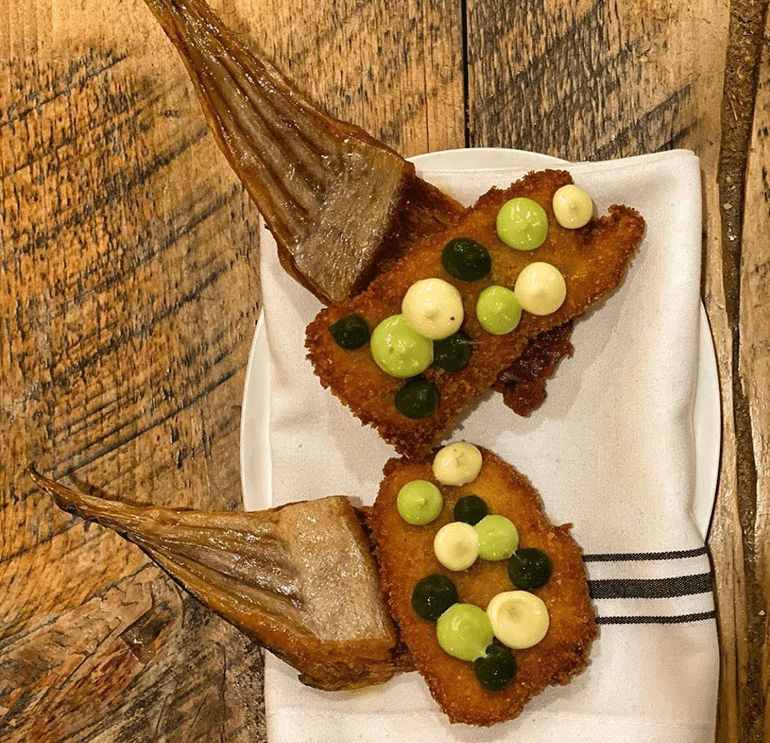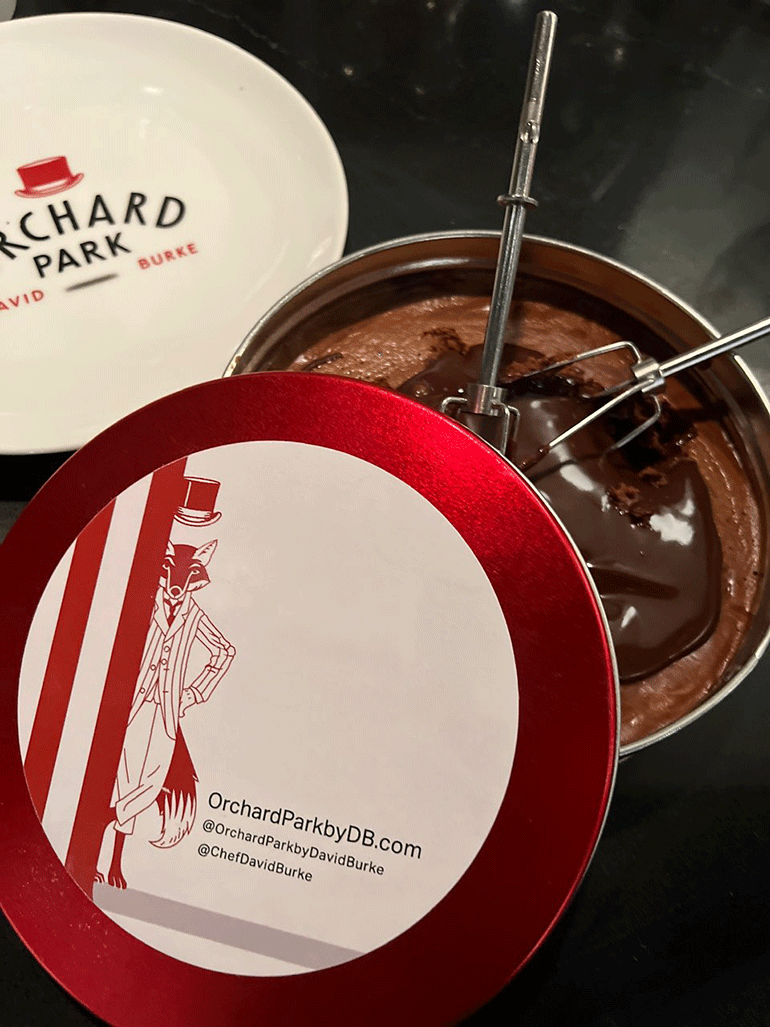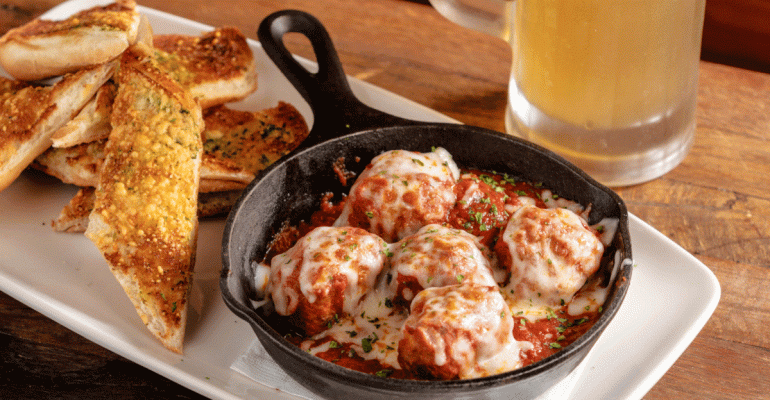Even restaurant veterans have learned a lot over the past two years. They can do more with less, package food better for off-premises dining, and adjust quickly to changes in regulations and their guests’ attitudes.
“There was no such thing as a ‘pivot,’” said Damian Sansonetti, chef and owner of Chaval in Portland, Maine, noting what was probably the most over-used word at the height of the pandemic. “You were pirouetting.”
Chaval serves halibut fillets in addition to cheeks, collars, ribs and wings, pictured.
When it comes to their menus, chefs have often made them smaller, more efficient and more flexible. Dishes have become simpler, ingredients are being cross-utilized better and local purveyors are appreciated even more.
“We’ve learned that it’s OK to have a smaller menu, and just keep it fresher and simpler,” said David Burke, who has been one of the country’s most innovative chefs since he was the opening chef of Park Avenue Café in 1992.
Burke now operates 19 restaurants, mostly in New York and New Jersey, but he also has two restaurants in Saudi Arabia as well as Red Salt and Cloud Bar in Charlotte, N.C., and Breckenridge Distillery Restaurant in Colorado.
He said that instead of the 12-14 main courses and appetizers that was more typical at his restaurants, he has found that having eight of each is fine as long as you keep it fresh and seasonal.
“Therefore you need less staff and have lower food cost because everything sells better and is turned over quicker,” he said.
“We learned that you can charge for bread — good bread — you can charge for water and you can charge for credit card processing fees,” he added, noting that customers often don’t want bread anyway and it only goes to waste.
Plate presentation is also simpler, he said.
“I think you get to that point anyway as you start aging as a chef and you realize that you don’t have to use microgreens,” he said. “For what reason do you put microgreens on a plate? Make it beautiful without the makeup. You buy a beautiful product, you cook it correctly … you’re hiding it with microgreens and baby carrots.”
Burke has also leaned in to making larger desserts, such as his $24 “Can-o-Cake” at Orchard Park by David Burke in East Brunswick, N.J., which serves up to four people. Or his 10-cheesecake lollipop tree that’s $18-$20 “depending on the zip code.”
The "Can-o-Cake" at Orchard Park by David Burke serves up to four people.
Those desserts are more dramatic when they’re brought out to the table, improving customers’ satisfaction and getting more tables to order it, and it helps solve the problem of parties staying longer with minimal return. “There’s four people at a table, one person orders a dessert and a coffee and we can’t get our table back,” he said.
Justin Cucci, the head of Edible Beats, which operates Denver restaurants Root Down, Linger, Vital Root, El Five and Ophelia’s Electric Soapbox, said he and his team have also been looking to simplify presentations as well as cooking techniques to save on costs and streamline operations.
“We’re looking at dishes and saying ‘Do we need two sauces on this dish? Do we need that that extra crispy shallot? Do we need microgreens?’” he said.
In fact, they have been doing blind taste tests to see if extra preparation work is really worth the trouble.
“We’ll sear something off and throw it in the oven, and then we’ll braise [a similar piece of meat] and sous-vide it and do everything else to see if it makes a difference. One takes way more time, energy and money, and the other one is way simpler. We’re definitely going the simpler route, and I honestly find that we’re not making concessions; we’re finding ways to bring flavors to dishes that maybe we’d overlooked by being a little too complex.”
Cucci said it helps that his menus tend to feature global flavors inspired by street foods that are made using more straightforward techniques.
“They don’t do as many gymnastics as chefs do sometimes,” he said, instead using simple techniques “and some broad, big flavors.”
Alex Tubero, director of culinary operations for the Civetta group, which operates New York City restaurants including Amali, Bar Marseille, Calissa and Juniper, has also taken a less-is-more approach with some dishes.
“There were useless garnishes and ingredients,” he said. For example, he might have sauced a steak with shallot, garlic, thyme and rosemary. He has since realized that they didn’t really need the shallot or rosemary.
He, too, is cutting back on microgreens.
“We used to love going to the farmers market and finding all these beautiful little greens that you would love to add to a dish. We used to have the cushion to do that. Now we might decide to take it out,” he said.
Tubero has also gotten more creative with his products.
“When we’re creating a menu, we look at every dish and see how things are cross-utilized,” he said. So trim from a filet mignon becomes a steak tartare. Shrimp bought for pasta is also used in a salad.
But for the tuna loin he uses for tuna carpaccio, he doesn’t turn the trim into a tuna tartare appetizer because that might cannibalize carpaccio sales. So instead he saves it to make into tartare canapes for cocktail parties, with cucumbers, a soy vinaigrette, wasabi cream and sesame seeds in mini-cones made out of wonton wrappers.
A hamachi tartare might have been an option at those parties in the past, but why do that when you’re already buying tuna?
Devin Kreller, the chef of Wood in Chicago, takes a similar approach, but perhaps a bit more extreme, buying whole sides of beef from local producers and turning it into steaks, tartares, burgers, smoked short ribs and more.
Although sourcing local product in the past has been costly, Kreller said that with commodity prices going up and supplies from broadline distributors being less reliable, the cost difference is less dramatic and he still gets the satisfaction he has always had of supporting local businesses and educating those guests who are interested in learning about local products.
An added bonus during this time of labor shortage is that his cooks see using local and sometimes unusual products as a perk — they learn more, and that makes them want to stay longer, Kreller said.
Scratch cooking is also a draw for cooks at chain restaurants, according to Alexander Sadowsky, director of culinary, beverage and menu innovation for Twin Peaks, a casual-dining chain based in Addison, Texas.
He said kitchen labor hasn’t been a problem for the chain’s 85 restaurants and he thinks that might be because his cooks actually get to cook.
“I think they don’t want to work at a super-factory restaurant,” he said. “Our staff loves the fact that we actually cook. They take so much pride in the fact that we’re teaching them to cook real food. It’s really good to see.”
And being able to cook has also helped adjust to supply-chain issues, since basic ingredients, such as raw chuck roast instead of pre-made pot roast “is the lowest common denominator in terms of supply chain,” he said.
“It’s what’s saving our butts right now.”
And of course he’s cross-utilizing: Trim from the hand-cut steak is being made into chili, and he’s working on repurposing it into kebabs and pastas.
“We’re just about to launch flat-bread pizzas, and one of them will be black-and-blue, just to use up that trim,” he said. “And it’s rib eye cap; it’s good steak.”
He said menu innovation continues to be important, because guests are craving food that’s new but also familiar, such as the chain’s house-made meatballs that are being used in a sandwich as well as a skillet.
“People went nuts with it,” he said, and each restaurant sold 100-200 orders a day.
Darryl Harmon, executive chef of six-unit Clinton Hall as well as Slate, all in New York City, also has cut down on SKUs by finding multiple uses for everything. He has three different chicken preparations. The spinach used in his salads is now being made into spanakopita.
Clinton Hall is known for its burgers, so he uses the same ingredients to make cheeseburger empanadas.
“That right there is one of our number one sellers,” he said.
Although he has cut his kitchen staff from four cooks per shift to two cooks — paying them around $22 per hour instead of $17 — he said the kitchens are actually functioning better.
“To be honest with you, we’re putting out better product with the four cooks [over two shifts] than with the eight cooks and the productivity is much more smooth,” he said. “I’m really excited about this new phase. It showed me some things.”
Sansonetti of Chaval said the trials of the pandemic have made him even more focused on supporting local purveyors, who have lost some of their regular customers over the past two years.
“Our menu has shifted and changed more to include even more local ingredients than before,” he said. It’s also included finding new ways to use everything he bought.
His chef de cuisine, Kirby Scholl, is an expert fish butcher who has been finding ways to serve not only halibut fillets and delectable cheeks and collars, but also ribs.
“He was treating halibut ribs like you would treat pork ribs,” Sansonetti said — marinating them and then grilling them low and slow.
“It’s like new barbecue,” he said.
Small “bullets” of meat off the fin can be floated in soup or made into dumplings, and Scholl is leaving the skin on fish tails and roasting them.
“The flesh is tender and delicious,” Sansonetti said.
The meat from the fins is being breaded and deep-fried, and the fins themselves are being used as serving vessels.
They also used the halibut head to make a headcheese, brining it overnight, poaching it, cooling it, picking the meat and cooking down the cooking liquid with all its natural gelatin. They mixed all of that with parsley, thyme and chives along with local seaweed and put it in a terrine mold. They serve it with garlic and parsley coulis and pickled local kelp.
Although Sansonetti said some of this, like the fish head cheese, was being done before the pandemic started, “this made us pause and look at how to, one way, be frugal about it, but it also gets your creative juices flowing.”
The pandemic has also had chefs think more about what their customers want, and that has changed over the past two years, said Greg Atkinson, chef and owner of Marché on Bainbridge Island in Washington.
Just to use up meat that he had at the beginning of the lockdown in March 2020, he added bacon-wrapped meat loaf to the menu — a stark departure from the very French fare he had always offered. And it’s still a top seller at the restaurant.
“It’s a little bit of a phenomenon,” he said.
He also added a French-style mac ’n’ cheese that has morphed into a daily pasta — usually something baked that doesn’t need to be made to order, for the sake of efficiency at service.
Labor-intensive items like trout and duck have become occasional specials, and he has done away with lunch for now.
“The menu got smaller. It got simpler, and surprisingly it got way better, because I’m able to focus more on the dishes that we kept,” he said.
“I loosened up on being so very French,” he added. “I didn’t call my meat loaf a gateau de viande, but meat loaf.”
His fried chicken Fridays also are a huge success, he said, and the velouté that he serves with it, made from the chicken bones, is called a cream gravy.
Overall sales are down, he said, but margins are up.
At the very high end, some chefs have doubled down on their focus on luxury. That’s what Daniel Rose is doing at Le Coucou in New York.
“We all looked at what we were doing and said, ‘Don’t hold back anymore,’” he said.
His beef tartare, made with USDA Prime fillet, is now topped with an ounce of osetra caviar — not to gild the lily, but because raw beef seasoned with a little anchovy and a subtle touch Tabasco sauce is delicious when topped with caviar. It’s $89.
“We never had côte de veau [veal chop] on the menu because it just cost too much,” he said. Now they’re using excellent veal from Pennsylvania that they didn’t think they could afford before and selling it for $64.
Customers are buying it, and Rose said his cooks love working with it.
Making his cooks happy is the practical reason for using premium ingredients, helped by the fact that his customers are willing to indulge. But he said that in these troubled times the move to be even more high-end than before is also spiritual.
“Life is short,” he said. “Why make concessions?”
Read more:
OPERATIONS: Sustainability moves up priority list after COVID’s shut-down lessons
SERVICE: Consumers will want to choose their own experience in a post-pandemic world
TECHNOLOGY: Virtual brands have matured from curious idea to pandemic life saver
COMMUNITY: How foodservice philanthropy rose to the occasion in unprecedented crisis
Contact Bret Thorn at [email protected]
Follow him on Twitter: @foodwriterdiary





